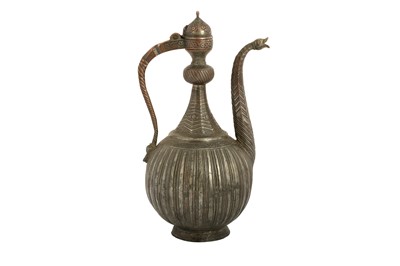16th Apr, 2021 13:00
Islamic & Indian Art
A TINNED COPPER EWER
Deccan, Central India, 17th century
A TINNED COPPER EWER
Deccan, Central India, 17th century
Of bulbous shape, resting on a short splayed foot, with a melon-shaped ribbed base rising to a tapering faceted neck and a circular mouth with domed hinged lid, with a bulging rounded ring just below the rim, to one side a rope-twisted sinuous handle and to the latter a curved spout terminating in an open-mouthed dragon or makara head, the exterior engraved with vertical lines on the body; overlapping chevron bands on the spout and neck; and bands of Safavid-style rosette tendrils on the shoulders, mouth, lid and first part of the handle, 34.5cm high.
Provenance: Bonhams Knightsbridge, 19 January 2011, lot 117.
Tinned copper vessels and ewers of this shape and style have long puzzled Islamic scholars, who have at times attributed them to Iran; other times to Northern India and Deccan; and occasionally even to the Ottoman lands. The truth, perhaps, lies in the middle: the quintessential motifs of these ewers were en vogue in different areas of the Islamic world and we would be mistaken in considering art as a static entity. It seems more likely to believe that some peculiar features of the decorative repertoire of 16th and 17th-century metal vessels would fluidly move from one production to the other, according to the taste of the time, of their makers and patrons. This is definitely the case with the so-called 'rosette bands' and 'dragon heads', recurrent elements in both Safavid and Indian metalwares.
According to Zebrowski, stylised dragon heads without fangs and crests, unlike the Timurid beasts, should be interpreted as makaras, Indian mythical aquatic creatures similar to a crocodile, and could thus be ascribed to India. In particular, if presenting a downward-turning knob at the end of the nose, the attribution should point at a southern origin, rather than northern (M. Zebrowski, Gold, Silver and Bronze from Mughal India, 1997, p.142). In the same publication, two ewers attributed to 16th-century Deccan (figs. 186 and 188) seem to share several common features with our example, including the rope-twisted design of the handle, the twisted fluting and slimness characterising the body, and the dragon or makara-headed spout, indicating a probable Deccani origin for our lot.
Sold for £2,500
Includes Buyer's Premium
Do you have an item similar to the item above? If so please click the link below to submit a free online valuation request through our website.




